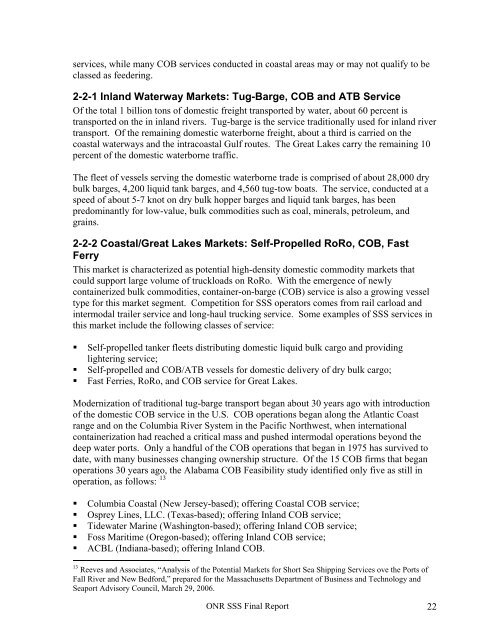Office of Naval Research - National Transportation Library
Office of Naval Research - National Transportation Library
Office of Naval Research - National Transportation Library
Create successful ePaper yourself
Turn your PDF publications into a flip-book with our unique Google optimized e-Paper software.
services, while many COB services conducted in coastal areas may or may not qualify to beclassed as feedering.2-2-1 Inland Waterway Markets: Tug-Barge, COB and ATB ServiceOf the total 1 billion tons <strong>of</strong> domestic freight transported by water, about 60 percent istransported on the in inland rivers. Tug-barge is the service traditionally used for inland rivertransport. Of the remaining domestic waterborne freight, about a third is carried on thecoastal waterways and the intracoastal Gulf routes. The Great Lakes carry the remaining 10percent <strong>of</strong> the domestic waterborne traffic.The fleet <strong>of</strong> vessels serving the domestic waterborne trade is comprised <strong>of</strong> about 28,000 drybulk barges, 4,200 liquid tank barges, and 4,560 tug-tow boats. The service, conducted at aspeed <strong>of</strong> about 5-7 knot on dry bulk hopper barges and liquid tank barges, has beenpredominantly for low-value, bulk commodities such as coal, minerals, petroleum, andgrains.2-2-2 Coastal/Great Lakes Markets: Self-Propelled RoRo, COB, FastFerryThis market is characterized as potential high-density domestic commodity markets thatcould support large volume <strong>of</strong> truckloads on RoRo. With the emergence <strong>of</strong> newlycontainerized bulk commodities, container-on-barge (COB) service is also a growing vesseltype for this market segment. Competition for SSS operators comes from rail carload andintermodal trailer service and long-haul trucking service. Some examples <strong>of</strong> SSS services inthis market include the following classes <strong>of</strong> service:• Self-propelled tanker fleets distributing domestic liquid bulk cargo and providinglightering service;• Self-propelled and COB/ATB vessels for domestic delivery <strong>of</strong> dry bulk cargo;• Fast Ferries, RoRo, and COB service for Great Lakes.Modernization <strong>of</strong> traditional tug-barge transport began about 30 years ago with introduction<strong>of</strong> the domestic COB service in the U.S. COB operations began along the Atlantic Coastrange and on the Columbia River System in the Pacific Northwest, when internationalcontainerization had reached a critical mass and pushed intermodal operations beyond thedeep water ports. Only a handful <strong>of</strong> the COB operations that began in 1975 has survived todate, with many businesses changing ownership structure. Of the 15 COB firms that beganoperations 30 years ago, the Alabama COB Feasibility study identified only five as still inoperation, as follows: 13• Columbia Coastal (New Jersey-based); <strong>of</strong>fering Coastal COB service;• Osprey Lines, LLC. (Texas-based); <strong>of</strong>fering Inland COB service;• Tidewater Marine (Washington-based); <strong>of</strong>fering Inland COB service;• Foss Maritime (Oregon-based); <strong>of</strong>fering Inland COB service;• ACBL (Indiana-based); <strong>of</strong>fering Inland COB.13 Reeves and Associates, “Analysis <strong>of</strong> the Potential Markets for Short Sea Shipping Services ove the Ports <strong>of</strong>Fall River and New Bedford,” prepared for the Massachusetts Department <strong>of</strong> Business and Technology andSeaport Advisory Council, March 29, 2006.ONR SSS Final Report 22
















